IPA Item Set v1.18.11 new items
Draft MDS3.0 IPA Item Set v1.18.11 Oct2023+ new items highlighted.docx
Minimum Data Set 3.0 Nursing Home and Swing Bed Prospective Payment System (PPS) for the Collection of Data Related to the Patient Driven Payment Model and the Skilled Nursing Facility QRP (CMS-10387)
IPA Item Set v1.18.11 new items
OMB: 0938-1140
Resident
Identifier
Date







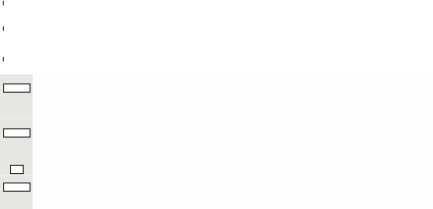
RESIDENT ASSESSMENT AND CARE SCREENING
 Interim
Payment
Assessment
(IPA)
Item
Set
Interim
Payment
Assessment
(IPA)
Item
Set
Section A |
Identification Information |
|
A0050. Type of Record |
||
Enter Code |
|
|
A0100. Facility Provider Numbers |
||
|
|
|
A0200. Type of Provider. |
||
Enter Code |
Type of provider
|
|
A0310. Type of Assessment |
||
Enter Code
Enter Code
Enter Code
Enter Code |
A. Federal OBRA Reason for Assessment
99. None of the above |
|
B. PPS Assessment. PPS Scheduled Assessment for a Medicare Part A Stay 01. 5-day scheduled assessment PPS Unscheduled Assessment for a Medicare Part A Stay. 08. IPA - Interim Payment Assessment Not PPS Assessment 99. None of the above |
||
E. Is this assessment the first assessment (OBRA, Scheduled PPS, or Discharge) since the most recent admission/entry or reentry?
|
||
F. Entry/discharge reporting 01. Entry tracking record
99. None of the above |
||
A0310 continued on next page |
||
Section A |
Identification Information |
|
A0310. Type of Assessment - Continued |
||
Enter Code |
G. Type of discharge - Complete only if A0310F = 10 or 11
|
|
A0410. Unit Certification or Licensure Designation |
||
Enter Code |
|
|
A0500. Legal Name of Resident. |
||
|
A. First name: B. Middle initial:
C. Last name: D. Suffix: |
|
A0600. Social Security and Medicare Numbers |
||
|
A. Social Security Number: _ _
B. Medicare number: |
|
A0700. Medicaid Number - Enter "+" if pending, "N" if not a Medicaid recipient |
||
|
|
|
A0800. Gender |
||
Enter Code |
|
|
A0900. Birth Date |
||
|
_ _ Month Day Year |
|
A1005. Ethnicity. Are you of Hispanic, Latino/a, or Spanish origin? |
||
Check all that apply |
||
|
A. No, not of Hispanic, Latino/a, or Spanish origin |
|
B. Yes, Mexican, Mexican American, Chicano/a |
||
C. Yes, Puerto Rican |
||
D. Yes, Cuban |
||
E. Yes, another Hispanic, Latino/a, or Spanish origin |
||
X. Resident unable to respond |
||
Y. Resident declines to respond |
||
















Section A |
Identification Information |
|
A1010. Race What is your race? |
||
Check all that apply. |
||
|
A. White |
|
B. Black or African American |
||
C. American Indian or Alaska Native |
||
D. Asian Indian |
||
E. Chinese |
||
F. Filipino |
||
G. Japanese. |
||
H. Korean |
||
I. Vietnamese |
||
J. Other Asian |
||
K. Native Hawaiian |
||
L. Guamanian or Chamorro |
||
M. Samoan |
||
N. Other Pacific Islander |
||
X. Resident unable to respond |
||
Y. Resident declines to respond |
||
Z. None of the above |
||
A1110. Language |
||
Enter Code |
A. What is your preferred language?
B. Do you need or want an interpreter to communicate with a doctor or health care staff?
9. Unable to determine |
|
A1200. Marital Status |
||
Enter Code |
|
|






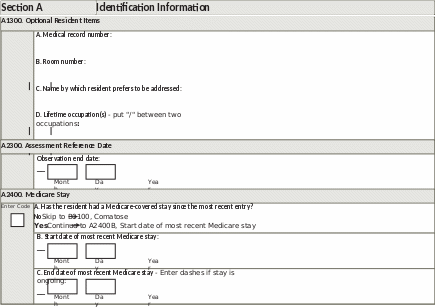



Section B |
Hearing, Speech, and Vision |
|
B0100. Comatose |
||
Enter Code |
Persistent vegetative state/no discernible consciousness
|
|
B0700. Makes Self Understood |
||
Enter Code |
Ability to express ideas and wants, consider both verbal and non-verbal expression
|
|
![]()






![]()
![]()
C0100. Should Brief Interview for Mental Status (C0200-C0500) be Conducted? Attempt to conduct interview with all residents |
|
Enter Code |
|
Brief Interview for Mental Status (BIMS) |
|||
C0200. Repetition of Three Words |
|||
Enter Code |
Ask resident: “I am going to say three words for you to remember. Please repeat the words after I have said all three. The words are: sock, blue, and bed. Now tell me the three words.” Number of words repeated after first attempt
After the resident's first attempt, repeat the words using cues ("sock, something to wear; blue, a color; bed, a piece of furniture"). You may repeat the words up to two more times. |
||
C0300. Temporal Orientation (orientation to year, month, and day) |
|||
Enter Code
Enter Code
Enter Code |
Ask resident: "Please tell me what year it is right now." A. Able to report correct year
|
||
Ask resident: "What month are we in right now?" B. Able to report correct month
|
|||
Ask resident: "What day of the week is today?" C. Able to report correct day of the week
|
|||
C0400. Recall |
|||
Enter Code
Enter Code
Enter Code |
Ask resident: "Let's go back to an earlier question. What were those three words that I asked you to repeat?" If unable to remember a word, give cue (something to wear; a color; a piece of furniture) for that word. A. Able to recall "sock"
|
||
B. Able to recall "blue"
|
|||
C. Able to recall "bed"
|
|||
C0500. BIMS Summary Score |
|||
Enter Score |
Add scores for questions C0200-C0400 and fill in total score (00-15) Enter 99 if the resident was unable to complete the interview |
||
|
|
|
|



![]()
![]()


C0600. Should the Staff Assessment for Mental Status (C0700 - C1000) be Conducted? |
|
Enter Code |
|
Staff Assessment for Mental Status |
|
Do not conduct if Brief Interview for Mental Status (C0200-C0500) was completed |
|
C0700. Short-term Memory OK |
|
Enter Code |
Seems or appears to recall after 5 minutes
|
C1000. Cognitive Skills for Daily Decision Making |
|
Enter Code |
Made decisions regarding tasks of daily life
|


![]()
![]()

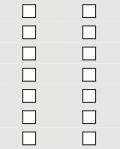

D0100. Should Resident Mood Interview be Conducted? - Attempt to conduct interview with all residents |
|
Enter Code |
|
![]() Copyright
©
Pfizer
Inc.
All
rights
reserved.
Reproduced
with
permission.
Copyright
©
Pfizer
Inc.
All
rights
reserved.
Reproduced
with
permission.
D0500.
Staff
Assessment
of
Resident
Mood
(PHQ-9-OV*) Do
not
conduct
if
Resident
Mood
Interview
(D0150-D0160)
was
completed
Over
the
last
2
weeks,
did
the
resident
have
any
of
the
following
problems
or
behaviors?
If
symptom
is
present,
enter
1
(yes)
in
column
1,
Symptom
Presence. Then
move
to
column
2,
Symptom
Frequency,
and
indicate
symptom
frequency. Symptom
Presence. 2.
Symptom
Frequency No
(enter
0
in
column
2) 0.
Never
or
1
day Yes
(enter
0-3
in
column
2) 1.
2-6
days
(several
days) 7-11
days
(half
or
more
of
the
days) 12-14
days
(nearly
every
day)
1.
Symptom
Presence
2.
Symptom
Frequency
A.
Little
interest
or
pleasure
in
doing
things
B.
Feeling
or
appearing
down,
depressed,
or
hopeless
C.
Trouble
falling
or
staying
asleep,
or
sleeping
too
much
D.
Feeling
tired
or
having
little
energy
E.
Poor
appetite
or
overeating
F.
Indicating
that
they
feel
bad
about
self,
are
a
failure,
or
have
let
self
or
family
down
G.
Trouble
concentrating
on
things,
such
as
reading
the
newspaper
or
watching
television
H.
Moving
or speaking so slowly that other people have noticed.
Or
the opposite - being so fidgety or
restless
that
they
have
been
moving
around
a
lot
more
than
usual
I.
States
that
life
isn't
worth
living,
wishes
for
death,
or
attempts
to
harm
self
J.
Being
short-tempered,
easily
annoyed
D0600.
Total
Severity
Score.
Enter
Score
Add
scores
for
all
frequency
responses
in
Column
2,
Symptom
Frequency.
Total
score
must
be
between
00
and
30.
![]() Enter
Scores in Boxes
Enter
Scores in Boxes
![]()
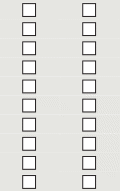

* Copyright © Pfizer Inc. All rights reserved.
Section E |
Behavior |
|||
E0100. Potential Indicators of Psychosis |
||||
Check all that apply |
||||
|
A. Hallucinations (perceptual experiences in the absence of real external sensory stimuli) |
|||
B. Delusions (misconceptions or beliefs that are firmly held, contrary to reality) |
||||
Z. None of the above |
||||
Behavioral Symptoms |
||||
E0200. Behavioral Symptom - Presence & Frequency |
||||
Note presence of symptoms and their frequency. |
||||
Coding:
but less than daily
|
Enter Codes in Boxes |
|||
|
A. Physical behavioral symptoms directed toward others (e.g., hitting, kicking, pushing, scratching, grabbing, abusing others sexually) |
|||
B. Verbal behavioral symptoms directed toward others (e.g., threatening others, screaming at others, cursing at others) |
||||
C. Other behavioral symptoms not directed toward others (e.g., physical symptoms such as hitting or scratching self, pacing, rummaging, public sexual acts, disrobing in public, throwing or smearing food or bodily wastes, or verbal/vocal symptoms like screaming, disruptive sounds) |
||||
E0800. Rejection of Care - Presence & Frequency |
||||
Enter Code |
Did the resident reject evaluation or care (e.g., bloodwork, taking medications, ADL assistance) that is necessary to achieve the resident's goals for health and well-being? Do not include behaviors that have already been addressed (e.g., by discussion or care planning with the resident or family), and determined to be consistent with resident values, preferences, or goals.
|
|||
E0900. Wandering - Presence & Frequency |
||||
Enter Code |
Has the resident wandered?
|
|||
![]()





Section GG |
Functional Abilities and Goals - OBRA/Interim |
|
GG0130. Self-Care (Assessment period is the ARD plus 2 previous calendar days) Complete column 5 when A0310A = 02 - 06 and A0310B = 99 or when A0310B = 08. |
||
Code the resident's usual performance for each activity using the 6-point scale. If an activity was not attempted, code the reason. |
||
Coding: Safety and Quality of Performance - If helper assistance is required because resident's performance is unsafe or of poor quality, score according to amount of assistance provided. Activities may be completed with or without assistive devices. 06. Independent - Resident completes the activity by themself with no assistance from a helper. 05. Setup or clean-up assistance - Helper sets up or cleans up; resident completes activity. Helper assists only prior to or following the activity. 04. Supervision or touching assistance - Helper provides verbal cues and/or touching/steadying and/or contact guard assistance as resident completes activity. Assistance may be provided throughout the activity or intermittently. 03. Partial/moderate assistance - Helper does LESS THAN HALF the effort. Helper lifts, holds, or supports trunk or limbs, but provides less than half the effort. 02. Substantial/maximal assistance - Helper does MORE THAN HALF the effort. Helper lifts or holds trunk or limbs and provides more than half the effort. 01. Dependent - Helper does ALL of the effort. Resident does none of the effort to complete the activity. Or, the assistance of 2 or more helpers is required for the resident to complete the activity. If activity was not attempted, code reason: 07. Resident refused 09. Not applicable - Not attempted and the resident did not perform this activity prior to the current illness, exacerbation, or injury 10. Not attempted due to environmental limitations (e.g., lack of equipment, weather constraints) 88. Not attempted due to medical condition or safety concerns |
||
5. OBRA/Interim Performance |
|
|
Enter Codes in Boxes
|
||
|
A. Eating: The ability to use suitable utensils to bring food and/or liquid to the mouth and swallow food and/or liquid once the meal is placed before the resident. |
|
B. Oral hygiene: The ability to use suitable items to clean teeth. Dentures (if applicable): The ability to insert and remove dentures into and from the mouth, and manage denture soaking and rinsing with use of equipment. |
||
C. Toileting hygiene: The ability to maintain perineal hygiene, adjust clothes before and after voiding or having a bowel movement. If managing an ostomy, include wiping the opening but not managing equipment.. |
||

Section GG |
Functional Abilities and Goals - OBRA/Interim |
|
GG0170. Mobility (Assessment period is the ARD plus 2 previous calendar days) Complete column 5 when A0310A = 02 - 06 and A0310B = 99 or when A0310B = 08. |
||
Code the resident's usual performance for each activity using the 6-point scale. If an activity was not attempted, code the reason. |
||
Coding: Safety and Quality of Performance - If helper assistance is required because resident's performance is unsafe or of poor quality, score according to amount of assistance provided. Activities may be completed with or without assistive devices. 06. Independent - Resident completes the activity by themself with no assistance from a helper. 05. Setup or clean-up assistance - Helper sets up or cleans up; resident completes activity. Helper assists only prior to or following the activity. 04. Supervision or touching assistance - Helper provides verbal cues and/or touching/steadying and/or contact guard assistance as resident completes activity. Assistance may be provided throughout the activity or intermittently. 03. Partial/moderate assistance - Helper does LESS THAN HALF the effort. Helper lifts, holds, or supports trunk or limbs, but provides less than half the effort. 02. Substantial/maximal assistance - Helper does MORE THAN HALF the effort. Helper lifts or holds trunk or limbs and provides more than half the effort. 01. Dependent - Helper does ALL of the effort. Resident does none of the effort to complete the activity. Or, the assistance of 2 or more helpers is required for the resident to complete the activity. If activity was not attempted, code reason: 07. Resident refused 09. Not applicable - Not attempted and the resident did not perform this activity prior to the current illness, exacerbation, or injury 10. Not attempted due to environmental limitations (e.g., lack of equipment, weather constraints) 88. Not attempted due to medical condition or safety concerns |
||
5. OBRA/Interim Performance |
|
|
Enter Codes in Boxes
|
||
|
B. Sit to lying: The ability to move from sitting on side of bed to lying flat on the bed. |
|
C. Lying to sitting on side of bed: The ability to move from lying on the back to sitting on the side of the bed and with no back support. |
||
D. Sit to stand: The ability to come to a standing position from sitting in a chair, wheelchair, or on the side of the bed.. |
||
E. Chair/bed-to-chair transfer: The ability to transfer to and from a bed to a chair (or wheelchair). |
||
F. Toilet transfer: The ability to get on and off a toilet or commode. |
||
I. Walk 10 feet: Once standing, the ability to walk at least 10 feet in a room, corridor, or similar space. If interim performance is coded 07, 09, 10, or 88 Skip to H0100, Appliances |
||
J. Walk 50 feet with two turns: Once standing, the ability to walk at least 50 feet and make two turns. |
||
K. Walk 150 feet: Once standing, the ability to walk at least 150 feet in a corridor or similar space. |
||
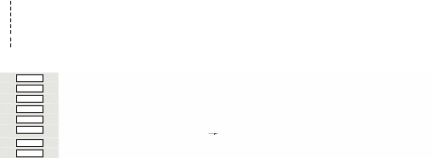







Section H |
Bladder and Bowel |
|
H0100. Appliances |
||
|
||
|
C. Ostomy (including urostomy, ileostomy, and colostomy) |
|
D. Intermittent catheterization |
||
Z. None of the above |
||
H0200. Urinary Toileting Program |
||
Enter Code |
C. Current toileting program or trial - Is a toileting program (e.g., scheduled toileting, prompted voiding, or bladder training) currently being used to manage the resident's urinary continence?
|
|
H0500. Bowel Toileting Program |
||
Enter Code |
Is a toileting program currently being used to manage the resident's bowel continence?
|
|
Section I |
Active Diagnoses |
|
I0020. Indicate the resident’s primary medical condition category |
||
Enter Code |
Indicate the resident's primary medical condition category that best describes the primary reason for admission
|
|
Section I |
Active Diagnoses |
|
Active Diagnoses in the last 7 days - Check all that apply Diagnoses listed in parentheses are provided as examples and should not be considered as all-inclusive lists |
||
|
Gastrointestinal |
|
I1300. Ulcerative Colitis, Crohn's Disease, or Inflammatory Bowel Disease |
||
Infections |
||
I1700. Multidrug-Resistant Organism (MDRO) I2000. Pneumonia I2100. Septicemia I2500. Wound Infection (other than foot) |
||
Metabolic |
||
I2900. Diabetes Mellitus (DM) (e.g., diabetic retinopathy, nephropathy, and neuropathy) |
||
Neurological |
||
I4300. Aphasia I4400. Cerebral Palsy I4500. Cerebrovascular Accident (CVA), Transient Ischemic Attack (TIA), or Stroke I4900. Hemiplegia or Hemiparesis I5100. Quadriplegia I5200. Multiple Sclerosis (MS) I5300. Parkinson's Disease I5500. Traumatic Brain Injury (TBI) |
||
Nutritional |
||
I5600. Malnutrition (protein or calorie) or at risk for malnutrition |
||
Pulmonary |
||
I6200. Asthma, Chronic Obstructive Pulmonary Disease (COPD), or Chronic Lung Disease (e.g., chronic bronchitis and restrictive lung diseases such as asbestosis) I6300. Respiratory Failure |
||
None of Above. |
||
I7900. None of the above active diagnoses within the last 7 days |
||
Other |
||
I8000. Additional active diagnoses Enter diagnosis on line and ICD code in boxes. Include the decimal for the code in the appropriate box.
A.
B.
C.
D.
E.
F.
G.
H.
I.
J. |
||











Section J |
Health Conditions |
|||
Other Health Conditions |
||||
J1100. Shortness of Breath (dyspnea) |
||||
Check all that apply |
||||
|
C. Shortness of breath or trouble breathing when lying flat |
|||
Z. None of the above |
||||
J1550. Problem Conditions |
||||
Check all that apply |
||||
|
A. Fever |
|||
B. Vomiting |
||||
Z. None of the above |
||||
J2100. Recent Surgery Requiring Active SNF Care |
||||
Enter Code |
Did the resident have a major surgical procedure during the prior inpatient hospital stay that requires active care during the SNF stay? 0. No. 1. Yes 8. Unknown |
|||
Surgical Procedures - Complete only if J2100 = 1 |
||||
Check all that apply |
||||
|
Major Joint Replacement |
|||
J2300. |
Knee Replacement - partial or total |
|||
J2310. |
Hip Replacement - partial or total |
|||
J2320. |
Ankle Replacement - partial or total |
|||
J2330. |
Shoulder Replacement - partial or total |
|||
Spinal Surgery |
||||
J2400. |
Involving the spinal cord or major spinal nerves |
|||
J2410. |
Involving fusion of spinal bones |
|||
J2420. |
Involving Iamina, discs, or facets |
|||
J2499. |
Other major spinal surgery |
|||
Other Orthopedic Surgery. |
||||
J2500. |
Repair fractures of the shoulder (including clavicle and scapula) or arm (but not hand) |
|||
J2510. |
Repair fractures of the pelvis, hip, leg, knee, or ankle (not foot) |
|||
J2520. |
Repair but not replace joints |
|||
J2530. |
Repair other bones (such as hand, foot, jaw) |
|||
J2599. |
Other major orthopedic surgery |
|||
Neurological Surgery |
||||
J2600. |
Involving the brain, surrounding tissue or blood vessels (excludes skull and skin but includes cranial nerves) |
|||
J2610. |
Involving the peripheral or autonomic nervous system - open or percutaneous |
|||
J2620. |
Insertion or removal of spinal or brain neurostimulators, electrodes, catheters, or CSF drainage devices |
|||
J2699. |
Other major neurological surgery |
|||
Cardiopulmonary Surgery. |
||||
J2700. |
Involving the heart or major blood vessels - open or percutaneous procedures |
|||
J2710. |
Involving the respiratory system, including lungs, bronchi, trachea, larynx, or vocal cords - open or endoscopic |
|||
J2799. |
Other major cardiopulmonary surgery |
|||
Genitourinary Surgery |
||||
J2800. |
Involving genital systems (such as prostate, testes, ovaries, uterus, vagina, external genitalia) |
|||
J2810. |
Involving the kidneys, ureters, adrenal glands, or bladder - open or laparoscopic (includes creation or removal of |
|||
|
nephrostomies or urostomies) |
|||
J2899. |
Other major genitourinary surgery. |
|||
![]()
![]()



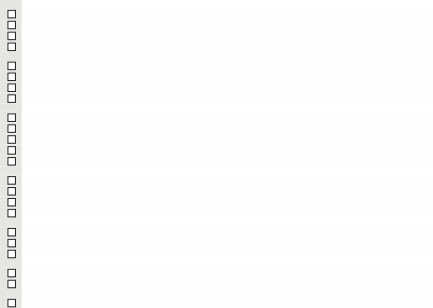




Section J |
Health Conditions |
|
Surgical Procedures - Continued |
||
|
||
|
Other Major Surgery. |
|
|
J2900. Involving tendons, ligaments, or muscles J2910. Involving the gastrointestinal tract or abdominal contents from the esophagus to the anus, the biliary tree, gall bladder, liver, pancreas, or spleen - open or laparoscopic (including creation or removal of ostomies or percutaneous feeding tubes, or hernia repair) J2920. Involving the endocrine organs (such as thyroid, parathyroid), neck, lymph nodes, or thymus - open J2930. Involving the breast J2940. Repair of deep ulcers, internal brachytherapy, bone marrow or stem cell harvest or transplant J5000. Other major surgery not listed above |
|
Section K |
Swallowing/Nutritional Status |
|||
K0100. Swallowing Disorder Signs and symptoms of possible swallowing disorder |
||||
|
||||
|
A. Loss of liquids/solids from mouth when eating or drinking |
|||
B. Holding food in mouth/cheeks or residual food in mouth after meals |
||||
C. Coughing or choking during meals or when swallowing medications |
||||
D. Complaints of difficulty or pain with swallowing |
||||
Z. None of the above |
||||
K0300. Weight Loss |
||||
Enter Code |
Loss of 5% or more in the last month or loss of 10% or more in last 6 months
|
|||
K0520. Nutritional Approaches Check all of the following nutritional approaches that apply. |
||||
2. While Not a Resident Performed while NOT a resident of this facility and within the last 7 days. Only check column 2 if resident entered (admission or reentry) IN THE LAST 7 DAYS. If resident last entered 7 or more days ago, leave column 2 blank. |
2. While Not a Resident. |
3. While a Resident |
||
3. While a Resident Performed while a resident of this facility and within the last 7 days |
Check all that apply |
|||
A. Parenteral/IV feeding |
|
|
||
B. Feeding tube (e.g., nasogastric or abdominal (PEG)) |
||||
C. Mechanically altered diet - require change in texture of food or liquids (e.g., pureed food, thickened liquids) |
|
|
||
Z. None of the above |
|
|||





Section K |
Swallowing/Nutritional Status |
||
K0710. Percent Intake by Artificial Route - Complete K0710 only if Column 2 and/or Column 3 are checked for K0520A and/or K0520B |
|||
Performed while a resident of this facility and within the last 7 days
Performed during the entire last 7 days |
2. While a Resident. |
3. During Entire 7 Days |
|
Enter Codes |
|||
A. Proportion of total calories the resident received through parenteral or tube feeding
|
|
|
|
B. Average fluid intake per day by IV or tube feeding
|
|||
Section M |
Skin Conditions |
|
Report based on highest stage of existing ulcers/injuries at their worst; do not "reverse" stage |
||
|
||
M0210. Unhealed Pressure Ulcers/Injuries |
||
Enter Code |
Does this resident have one or more unhealed pressure ulcers/injuries?
|
|
M0300. Current Number of Unhealed Pressure Ulcers/Injuries at Each Stage |
||
Enter Number
Enter Number
Enter Number |
B. Stage 2: Partial thickness loss of dermis presenting as a shallow open ulcer with a red or pink wound bed, without slough. May also present as an intact or open/ruptured blister
1. Number of Stage 2 pressure ulcers |
|
C. Stage 3: Full thickness tissue loss. Subcutaneous fat may be visible but bone, tendon or muscle is not exposed. Slough may be present but does not obscure the depth of tissue loss. May include undermining and tunneling
1. Number of Stage 3 pressure ulcers |
||
D. Stage 4: Full thickness tissue loss with exposed bone, tendon or muscle. Slough or eschar may be present on some parts of the wound bed. Often includes undermining and tunneling
1. Number of Stage 4 pressure ulcers |
||
F. Unstageable - Slough and/or eschar: Known but not stageable due to coverage of wound bed by slough and/or eschar
1. Number of unstageable pressure ulcers due to coverage of wound bed by slough and/or eschar |
||
Enter Number |
||
Section M |
Skin Conditions |
|
M1030. Number of Venous and Arterial Ulcers |
||
Enter Number |
Enter the total number of venous and arterial ulcers present. |
|
M1040. Other Ulcers, Wounds and Skin Problems |
||
Check all that apply |
||
|
Foot Problems |
|
A. Infection of the foot (e.g., cellulitis, purulent drainage) |
||
B. Diabetic foot ulcer(s) |
||
C. Other open lesion(s) on the foot |
||
Other Problems |
||
D. Open lesion(s) other than ulcers, rashes, cuts (e.g., cancer lesion) |
||
E. Surgical wound(s) |
||
F. Burn(s) (second or third degree) |
||
None of the Above |
||
Z. None of the above were present |
||
M1200. Skin and Ulcer/Injury Treatments |
||
Check all that apply |
||
|
A. Pressure reducing device for chair |
|
B. Pressure reducing device for bed |
||
C. Turning/repositioning program |
||
D. Nutrition or hydration intervention to manage skin problems |
||
E. Pressure ulcer/injury care |
||
F. Surgical wound care |
||
G. Application of nonsurgical dressings (with or without topical medications) other than to feet |
||
H. Applications of ointments/medications other than to feet |
||
I. Application of dressings to feet (with or without topical medications) |
||
Z. None of the above were provided |
||




Section N |
Medications |
|
N0350. Insulin |
||
Enter Days
Enter Days |
A. Insulin injections - Record the number of days that insulin injections were received during the last 7 days or since admission/entry or reentry if less than 7 days |
|
B. Orders for insulin - Record the number of days the physician (or authorized assistant or practitioner) changed the resident's insulin orders during the last 7 days or since admission/entry or reentry if less than 7 days |
||
Section O |
Special Treatments, Procedures, and Programs |
||
O0110. Special Treatments, Procedures, and Programs Check all of the following treatments, procedures, and programs that were performed |
|||
b. While a Resident Performed while a resident of this facility and within the last 14 days |
b. While a Resident |
||
Check all that apply
|
|||
Cancer Treatments |
|||
A1. Chemotherapy |
|
||
B1. Radiation |
|||
Respiratory Treatments |
|||
C1. Oxygen therapy |
|
||
D1. Suctioning |
|||
E1. Tracheostomy care |
|||
F1. Invasive Mechanical Ventilator (ventilator or respirator) |
|||
Other |
|||
H1. IV Medications |
|
||
I1. Transfusions |
|||
J1. Dialysis |
|||
M1. Isolation or quarantine for active infectious disease (does not include standard body/fluid precautions) |
|||
None of the Above |
|||
Z1. None of the above |
|
||
O0400. Therapies |
|||
Enter Number of Days |
D. Respiratory Therapy |
||
2. Days - record the number of days this therapy was administered for at least 15 minutes a day in the last 7 days |
|||













Section O |
Special Treatments, Procedures, and Programs |
|
O0500. Restorative Nursing Programs |
||
Record the number of days each of the following restorative programs was performed (for at least 15 minutes a day) in the last 7 calendar days (enter 0 if none or less than 15 minutes daily) |
||
Number of Days |
Technique. |
|
|
A. Range of motion (passive) |
|
B. Range of motion (active) |
||
C. Splint or brace assistance |
||
Number of Days |
Training and Skill Practice In: |
|
|
D. Bed mobility |
|
E. Transfer |
||
F. Walking |
||
G. Dressing and/or grooming |
||
H. Eating and/or swallowing |
||
I. Amputation/prostheses care |
||
J. Communication |
||
Section X |
Correction Request |
|
Complete Section X only if A0050 = 2 or 3 Identification of Record to be Modified/Inactivated - The following items identify the existing assessment record that is in error. In this section, reproduce the information EXACTLY as it appeared on the existing erroneous record, even if the information is incorrect. This information is necessary to locate the existing record in the National MDS Database. |
||
X0150. Type of Provider (A0200 on existing record to be modified/inactivated) |
||
Enter Code |
Type of provider
|
|
X0200. Name of Resident (A0500 on existing record to be modified/inactivated) |
||
|
A. First name:
C. Last name: |
|
X0300. Gender (A0800 on existing record to be modified/inactivated) |
||
Enter Code |
|
|
X0400. Birth Date (A0900 on existing record to be modified/inactivated) |
||
|
_ _ Month Day Year |
|
Section X |
Correction Request |
|
X0500. Social Security Number (A0600A on existing record to be modified/inactivated) |
||
|
_ _ |
|
X0600. Type of Assessment (A0310 on existing record to be modified/inactivated) |
||
Enter Code
Enter Code
Enter Code |
A. Federal OBRA Reason for Assessment
99. None of the above |
|
B. PPS Assessment. PPS Scheduled Assessment for a Medicare Part A Stay. 01. 5-day scheduled assessment PPS Unscheduled Assessment for a Medicare Part A Stay 08. IPA - Interim Payment Assessment Not PPS Assessment. 99. None of the above |
||
F. Entry/discharge reporting 01. Entry tracking record
99. None of the above |
||
X0700. Date on existing record to be modified/inactivated |
||
|
A. Assessment Reference Date (A2300 on existing record to be modified/inactivated) - Complete only if X0600B = 08 _ _ Month Day Year |
|
Correction Attestation Section - Complete this section to explain and attest to the modification/inactivation request |
||
X0800. Correction Number |
||
Enter Number |
Enter the number of correction requests to modify/inactivate the existing record, including the present one |
|
X0900. Reasons for Modification - Complete only if Type of Record is to modify a record in error (A0050 = 2) |
||
Check all that apply |
||
|
A. Transcription error |
|
B. Data entry error |
||
C. Software product error |
||
D. Item coding error. |
||
Z. Other error requiring modification If "Other" checked, please specify: |
||
![]()




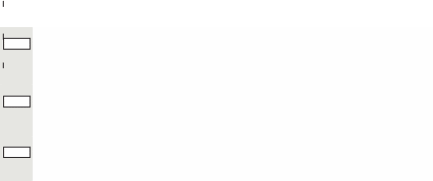





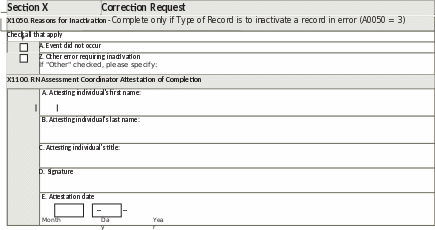

Section Z |
Assessment Administration |
|
Z0100. Medicare Part A Billing |
||
|
|
|
Section Z |
Assessment Administration |
||||
Z0400. Signature of Persons Completing the Assessment or Entry/Death Reporting |
|||||
|
I certify that the accompanying information accurately reflects resident assessment information for this resident and that I collected or coordinated collection of this information on the dates specified. To the best of my knowledge, this information was collected in accordance with applicable Medicare and Medicaid requirements. I understand that this information is used as a basis for ensuring that residents receive appropriate and quality care, and as a basis for payment from federal funds. I further understand that payment of such federal funds and continued participation in the government-funded health care programs is conditioned on the accuracy and truthfulness of this information, and that I may be personally subject to or may subject my organization to substantial criminal, civil, and/or administrative penalties for submitting false information. I also certify that I am authorized to submit this information by this facility on its behalf. |
||||
Signature |
Title |
Sections |
Date Section Completed |
||
A. |
|
|
|
||
B. |
|
|
|
||
C. |
|
|
|
||
D. |
|
|
|
||
E. |
|
|
|
||
F. |
|
|
|
||
G. |
|
|
|
||
H. |
|
|
|
||
I. |
|
|
|
||
J. |
|
|
|
||
K. |
|
|
|
||
L. |
|
|
|
||
Z0500. Signature of RN Assessment Coordinator Verifying Assessment Completion |
|||||
|
A. Signature: B. Date RN Assessment Coordinator signed assessment as complete: _ _ Month Day Year |
||||




Legal Notice Regarding MDS 3.0 - Copyright 2011 United States of America and interRAI. This work may be freely used and distributed solely within the United States. Portions of the MDS 3.0 are under separate copyright protections; Pfizer Inc. holds the copyright for the PHQ-9; Confusion Assessment Method. © 1988, 2003, Hospital Elder Life Program. All rights reserved. Adapted from: Inouye SK et al. Ann Intern Med. 1990; 113:941-8. Both Pfizer Inc. and the Hospital Elder Life Program, LLC have granted permission to use these instruments in association with the MDS 3.0.
MDS 3.0
Interim
Payment
Assessment
(IPA)
Version
1.18.11
Effective
10/01/2023
Page


| File Type | application/vnd.openxmlformats-officedocument.wordprocessingml.document |
| File Title | MDS 3.0 Interim Payment Assessment (IPA) Item Set |
| Subject | MDS 3.0 assessment items for Interim Payment Assessment (IPA) Item Set |
| Author | CMS |
| File Modified | 0000-00-00 |
| File Created | 2023-09-02 |
© 2025 OMB.report | Privacy Policy

